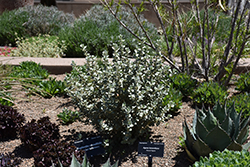It's all about ...
plants

Roundleaf Buffaloberry
Shepherdia rotundifolia
Height: 6 feet
Spread: 5 feet
Sunlight:
![]()
Hardiness Zone: 6a
Other Names: Silverleaf
Description:
A tough, drought tolerant plant that is great for xeric environments; features showy, oval shaped silver leaves and small, fragrant yellow-green flowers in spring; silvery-red berries follow in fall; ideal for poor alkaline soils
Ornamental Features
Roundleaf Buffaloberry has attractive grayish green foliage with hints of silver on a plant with an oval habit of growth. The fuzzy oval leaves are highly ornamental and remain grayish green throughout the winter. It is bathed in stunning clusters of fragrant yellow flowers with chartreuse overtones along the branches from mid to late spring. The smooth gray bark and silver branches are extremely showy and add significant winter interest.
Landscape Attributes
Roundleaf Buffaloberry is a multi-stemmed evergreen shrub with a shapely oval form. Its average texture blends into the landscape, but can be balanced by one or two finer or coarser trees or shrubs for an effective composition.
This shrub will require occasional maintenance and upkeep, and is best pruned in late winter once the threat of extreme cold has passed. It is a good choice for attracting birds to your yard. It has no significant negative characteristics.
Roundleaf Buffaloberry is recommended for the following landscape applications;
- Mass Planting
- Rock/Alpine Gardens
- General Garden Use
- Naturalizing And Woodland Gardens
Planting & Growing
Roundleaf Buffaloberry will grow to be about 6 feet tall at maturity, with a spread of 5 feet. It has a low canopy with a typical clearance of 1 foot from the ground, and is suitable for planting under power lines. It grows at a medium rate, and under ideal conditions can be expected to live for approximately 25 years.
This shrub should only be grown in full sunlight. It prefers dry to average moisture levels with very well-drained soil, and will often die in standing water. It is considered to be drought-tolerant, and thus makes an ideal choice for xeriscaping or the moisture-conserving landscape. This plant is capable of fixing its own nitrogen, which means that it is effectively self-fertilizing. As a result it should not require supplemental fertilizing, and if you do fertilize it, be sure to only use a low-nitrogen fertilizer to promote root growth. It is particular about its soil conditions, with a strong preference for poor, alkaline soils, and is able to handle environmental salt. It is highly tolerant of urban pollution and will even thrive in inner city environments. This species is native to parts of North America.
This plant is not reliably hardy in our region, and certain restrictions may apply; contact the store for more information.
